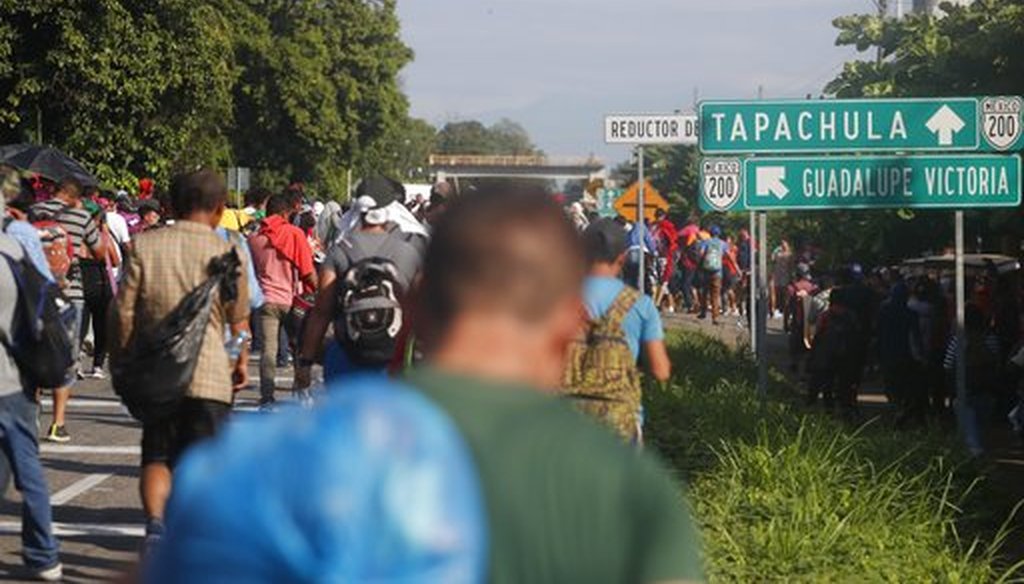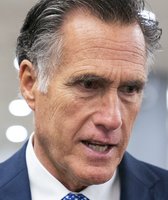Stand up for the facts!
Our only agenda is to publish the truth so you can be an informed participant in democracy.
We need your help.
I would like to contribute

Central American migrants walk north toward Tapachula, after departing Ciudad Hidalgo, Mexico, Sunday, Oct. 21, 2018. (AP Photo/Moises Castillo)
President Donald Trump said the United States was under assault by some Central American countries because many of their citizens were trekking north in a caravan and seeking entry into the United States.
People in the caravan have cited violence and economic hardship as factors driving them out of their homelands. Most are believed to be from Honduras. They began walking Oct. 13.
In a series of tweets Oct. 18, Trump berated leadership in El Salvador, Honduras and Guatemala for not doing enough to stop the caravan; claimed there were "many criminals" among the men, women and children; threatened to stop "all payments" to the countries; asked Mexico "to stop this onslaught" and warned that if it didn’t, he would call on the U.S. military to "close" the southern border.
On Oct. 22, after many in the caravan crossed into Mexico and continued their journey to the United States, Trump tweeted that "criminals and unknown Middle Easterners are mixed in" and that he alerted the U.S. Border Patrol and military that this was a national emergency.
Trump in April similarly reproached another caravan of more than 1,000 people. In that case, not all tried to get into the United States, as some remained in Mexico.
Here’s what we know about this new caravan.
Who’s in the caravan and why are they coming?
The caravan in April was organized by Pueblo Sin Fronteras, an organization that provides humanitarian aid and legal advice to migrants and refugees. But this time, there isn’t a clear organizer, although someone with Pueblo Sin Fronteras was detained in connection to the caravan and the group has been making statements about the march.
Some news reports initially said the caravan consisted of about 2,000 men, women and children. But more people joined the caravan in recent days, with new reports pegging the number from 5,000 to more than 7,000.
Pueblos sin Fronteras said the migrants left Honduras on Oct. 13 to escape violence and social upheaval caused by "decades of political, economic and military intervention by the United States and of negligence, coups d’état, insecurity, corruption and impunity by Central America’s governments."
Some migrants are reportedly seeking asylum in the United States, an immigration protection granted to people with credible fear of persecution on account of race, religion, nationality, or membership in a particular social group or political opinion. To apply for asylum, immigrants must be physically present in the United States.
Others are coming citing economic hardship in their countries.
Are "unknown Middle Easterners" coming in the caravan?
Trump has not provided supporting evidence. ABC News, which has a crew traveling with the caravan, said they had not seen evidence to support Trump’s claim.
Trump, known for watching Fox News, might be connecting "unknown Middle Easterners" to a claim made by Pete Hegseth, co-host of Fox & Friends Weekend.
"You got the president of Guatemala saying to a local newspaper down there, just last week, they caught over 100 ISIS fighters in Guatemala. … He talked to their local newspaper, we don’t know it hasn’t been verified, but even one ISIS, even one poison pill is too many in a caravan," Hegseth said Oct. 22.
Prensa Libre on Oct. 11 reported that Guatemalan president Jimmy Morales at a conference said "close to 100 people" linked to ISIS had been detained and deported to their home countries.
Mario Duarte, Guatemala’s secretary of Strategic Intelligence, also told Prensa Libre that close to 100 people had been intercepted, detained, processed or returned to their home countries. Duarte offered as an example the 2016 arrest and subsequent deportation of several people originally from Syria who had false documentation, Prensa Libre reported.
What is Mexico doing about the caravan?
Mexico’s government on Oct. 18 said it was requesting support from the Office of the United Nations High Commissioner for Refugees to help process refugee applications. It said anyone seeking to enter its country had to comply with immigration laws at authorized entry points.
Mexico’s foreign ministry also said it would not permit entry into Mexico if requirements to travel to a neighboring country have not been met.
Can Trump send the U.S. military to the border?
It’s plausible for Trump to send the military to the U.S. southwest border, but the caravan would have to first successfully pass through Mexico, said Rachel Schmidtke, program associate for migration at the Mexico Institute of the Wilson Center, a nonpartisan research group.
The number of people who get to the U.S. border could be significantly lower than the number arriving in Mexico, Schmidtke said, given Mexico’s enforcement actions and migration laws.
"If there are a significant amount of migrants projected to arrive, Trump may seek to send troops down purely to send a message to Central America and Mexico that the U.S. is determined to continue its strict immigration policies," Schmidtke said.
Earlier this year when a smaller caravan was making its way to the United States, Trump ordered the deployment of the National Guard to the border. The Posse Comitatus Act of 1878 restricts the military from engaging in civil law enforcement. But troops can be sent to support Border Patrol agents.
Most of the people coming to the border in this caravan are families seeking asylum, Schmidtke said. "Military presence is not equipped to deal with asylum seekers," she said. "It’s plausible, but ineffective."
What about cutting foreign aid to Central American countries?
It’s not feasible for Trump to cut all aid and assistance to these countries for this 2019 fiscal year because most of the aid has already been earmarked and signed by Trump, Schmidtke said. "Once the president has signed these appropriations, he cannot sign an executive order contrary to this," she said.
Trump could propose slashing future aid, but that plan will have to go through Congress, Schmidtke said.
The United States provides assistance to nations in Latin America and the Caribbean to support development and other U.S. objectives — and cuts in foreign aid could impact U.S. policy and influence in those countries, said a May 2018 report from the Congressional Research Service.
Eliminating aid to Central American nations could also lead to more migration to the United States. That’s the opposite of what Trump wants.
The assistance gives the United States ability to influence policies in other countries, including investments in counternarcotics operations and other operations that otherwise may not be top priorities for them, said the report.
Will Trump’s tweets stop people from coming to the United States?
That’s unlikely, Schmidtke said.
Trump saying he will cut foreign aid means little to people migrating due to poverty, insecurity, and violence. "They are likely not seeing any direct benefits from foreign aid, so this is not a threat to them," Schmidtke said.
Threats to "close" the border aren’t likely to deter migrants, either — people are still coming even after Trump’s rhetoric during the April caravan, after family separations at the border and the implementation of the "zero-tolerance" policy, Schmidtke added.
"The structural forces and push factors driving people out of the Northern Triangle are strong enough that they are willing to risk the consequences," she said.
Our Sources
Univision.com, Diario de la nueva caravana: migrantes siguen a la espera de que México les dé paso, daily updates on the caravan, last accessed Oct. 19, 2018
Twitter, @PuebloSF tweet, Oct. 18, 2018
Twitter, @realdonaldtrump tweet, tweet, tweet, Oct. 18
PolitiFact, Donald Trump says caravans of people coming through Mexico to cross U.S. border, April 2, 2018
WRAL.com, Pressure turns to Mexico as migrant caravan heads for border, Oct. 18, 2018
PolitiFact, No, immigrants cannot apply for asylum at U.S. embassies or consulates abroad, July 10, 2018
Gob.mx, Mexico Requests the Support of the UN with the Migrant Caravan, Oct. 18, 2018
PolitiFact, Can President Donald Trump send the military to secure the border?, April 4, 2018
Congressional Research Service, U.S. Foreign Assistance to Latin America and the Caribbean: FY2018 Appropriations, May 9, 2018
PolitiFact, The latest on reunification of families separated at the border, Trump immigration policy, July 12, 2018
PolitiFact, What you need to know about the Trump administration’s zero-tolerance immigration policy, June 6, 2018
Prensalibre.com, Ejecutivo se reserva información sobre capturas de ISIS, Oct. 11, 2018
AP, Ragged, growing caravan of migrants resumes march toward US, Oct. 21, 2018
LA Times, Stretching for miles, 7,000-strong migrant caravan treks through stifling heat in southern Mexico, Oct. 21, 2018


 PolitiFact Rating:
PolitiFact Rating: 







































